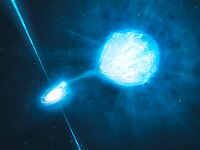
Photo from wikipedia
Quiescent black hole X-ray binaries (X-ray luminosities ${\lesssim} 10^{34}\,{\rm erg}\, {\rm s}^{-1}$) are believed to be fed by hot accretion flows that launch compact, relativistic jets. However, due to their… Click to show full abstract
Quiescent black hole X-ray binaries (X-ray luminosities ${\lesssim} 10^{34}\,{\rm erg}\, {\rm s}^{-1}$) are believed to be fed by hot accretion flows that launch compact, relativistic jets. However, due to their low luminosities, quiescent jets have been detected in the radio waveband from only five systems so far. Here, we present radio observations of two quiescent black hole X-ray binaries with the Australia Telescope Compact Array. One system, GS 1124-684, was not detected. The other system, BW Cir, was detected over two different epochs in 2018 and 2020, for which we also obtained quasi-simultaneous X-ray detections with Chandra and Swift. BW Cir is now the sixth quiescent X-ray binary with a confirmed radio jet. However, the distance to BW Cir is uncertain, and we find that BW Cir shows different behaviour in the radio/X-ray luminosity plane depending on the correct distance. Estimates based on its G-type subgiant donor star place BW Cir at >25 kpc, while initial optical astrometric measurements from Gaia Data Release 2 suggested likely distances of just a few kpc. Here, we use the most recent measurements from Gaia Early Data Release 3 and find a distance $d=7.1^{+4.8}_{-3.9}$ kpc and a potential kick velocity PKV = $165^{+81}_{-17}$ km s−1, with distances up to ≈20 kpc possible based on its parallax and proper motion. Even though there is now less tension between the parallax and donor-star based distance measurements, it remains an unresolved matter, and we conclude with suggestions on how to reconcile the two measurements.
Journal Title: Monthly Notices of the Royal Astronomical Society
Year Published: 2021
Link to full text (if available)
Share on Social Media: Sign Up to like & get
recommendations!